 |
 |
| 水野窯めぐり (No.1) Visit to Kilns at Mizuno area in Seto City [Photos taken on Apr.12, 2003] |
| 2003年4月12日(土)雨が降りしきる中、瀬戸市民公園駐車場兼「窯めぐり総合案内所」 でマップを頂いて第5回水野窯めぐり(4月12日と13日午前9:00〜午後4;00開催; ホームページ)へ行ってきました。瀬戸市の水野地区でこの窯めぐりに協賛されている 約20の窯元が各々の工房を公開し、新作品や市販していないお値打ちな陶器・陶磁器を そろえています。 小生は、この内、6軒の窯元の工房へ行ってきました。 水野川沿いは 桜が特にきれいで、来年は花見見物を兼ねて来ようと思います。以下に訪問した窯元の 一部をご紹介します。 昨年(2002年11月)は瀬戸市の赤津地区の窯めぐりをし、これぞ陶芸家の里と感動したら 、水野地区の窯にも非常に感銘しました。 赤津地区と違い、地区面積当たり窯元の 件数(半径600m位の地区に約20の窯元)は少ないですが、陶器・陶磁器に関する技術 知識や熱意は赤津地区の窯元と遜色ないようでした。小生の憶測ですが、赤津地区 に比べ歴史や伝統などにそれほど拘束されないので、創造性が高いかもしれません。 縄文時代以前の石器時代から7000年以上にわたり石器→土器→須恵器→陶器→陶磁器 生産の歴史をち、今日も陶器・陶磁器を生産する都市は世界でも中国の景徳鎮と陶都 瀬戸市のみであり、日本一すばらしい陶芸の里とつくづく実感しました。 これまでに瀬戸市内で訪問した窯元の人々は皆、親切で専門知識もしっかり持たれており、 全く俗化していないことにも感心しました。 While it rains incessantly, I received a map, "The 5th Excursion to Kilns in Mizuno area, Seto City." at the extraordinary parking lot of Seto Citizen Park which served as the comprehensive information desk. Then I stareted to making an excursion there. (The excursion program is held for am9:00 to pm4:00 on Aprl 12 and 13, 2003; .Web page) About 20 potteries participated in this program and made public their studios to show new ceramic products or products not in market. Among them, I visited 6 potteries. Especially the cherry tree along the Mizuno river is beautiful, and I will visit here while viewing cherry-blossom next year.again. I introduce the part of the potteries which I visited below. In November, 2002, I made an excursion to Akazu potteries, Seto City (Akazu is Parents' Home of Potters worldwide as well as in Japan). I was impressed with potteries at Mizuno too. Different from Akazu area, the density of number of potteries is low (about 20 potteries in the range of about radius 600 m) compared to the one in Akazu. But, it seemed that the potters in Mizuno can stand comparison with those in Akazu in technical knowledge or zeal about a porcelain/pottery. Since Mizuno area is bound by so much by neither history nor tradition compared with the Akatsu area, creativity may be high. For more than 7,000 years since the Stone Age before the Jomon Period, Seto has been producing ceramics (stone ware → earthenware → Sueki-ware → pottery → porcelain) and is still producing them. Besides Seto, the ceramic capital in Japan, only Keitokuchin in China is producing ceramics continuously for such a long period. All the potteries I have visited until now are kind and have enough technical knowledge. Furthermore, the area are not vulgarized. Those makes me feel comfortable. |
| 美夜之窯(注1と注2) (窯側から橋を見る) Miyanogama pottery(Note1 and Note2) (Viewing a bridge from the pottery) |
美夜之窯 (高さ約80cmの作品) Miyanogama pottery Work with a height of 80 cm |
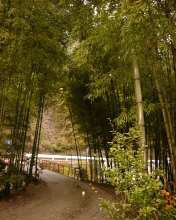 |
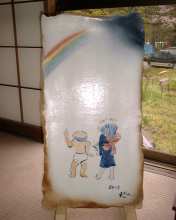 |
| 美夜之窯 (竹やぶから窯へ) Miyanogama pottery (Path from bamboo grove to the pottery) |
美夜之窯 (陶房正面) Miyanogama pottery (Front of atelier) |
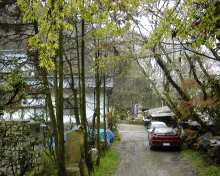 |
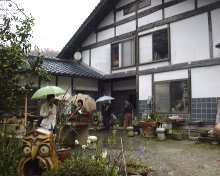 |
| 美夜之窯 (ピザを焼く窯) Miyanogama pottery (Pizza-burning kiln) |
美夜之窯 (火鉢テーブル) Miyanogama pottery (Hibachi-table) |
美夜之窯 (黒陶のオブジェ) Miyanogama pottery (Objet d'art of black glazed pottery) |
 |
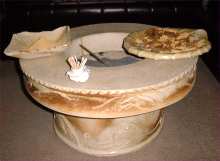 |
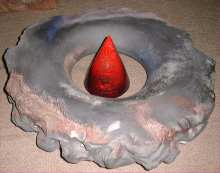 |
| 曽根窯 (注3) Sonegama pottery (Note 3) |
曽根窯 (注4) Sonegama pottery (Note4) |
 |
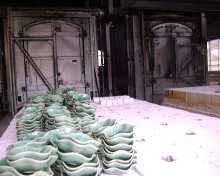 |
| 曽根窯 (注5 乾燥室) Sonegama pottery (Note5 Drying room) |
曽根窯 (陶製置物の見本) Sonegama pottery (Samples of pottery work) |
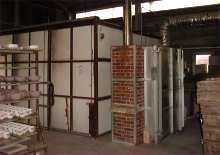 |
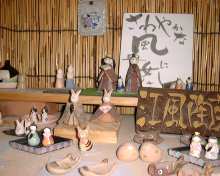 |
| 陶工房樋ケ沢(注6) (注7 和絵具) Atelier Tougasawa (Note6) (Note7 Japanese style paint) |
陶工房樋ケ沢 (注8 釉裏紅) Atelier Tougasawa (Note8 Yuuri-kou) |
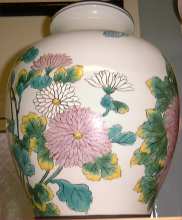 |
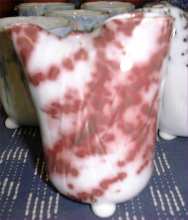 |
| 陶工房樋ケ沢 (注7 洋絵具) Atelier Tougasawa (Note7 Western style paint) |
陶工房樋ケ沢 (注8 釉裏青) Atelier Tougasawa (Note8 Yuuri-sei)) |
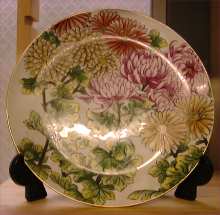 |
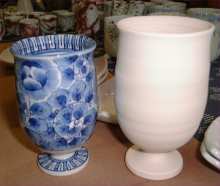 |
| 陶工房樋ケ沢 (注7 壷) Atelier Tougasawa (Note7 Jar) |
陶工房樋ケ沢 (注8 染付焼) Atelier Tougasawa (Note8 Sometuke-yaki) |
 透明釉薬掛け(下) 白の釉薬掛け(左上) Applied by transparent glazing agent (lower) Applied by white glazing agent (upper) |
 |
| 《注 Note》 1 美夜之窯(みやのがま)へのアクセス 瀬戸市民公園の東の南北に伸びる地方道を北へ約400m直進、上水野の交差点 を更に約300m直進し曽野の交差点を右折、約200mで水野川に掛かっている橋を 渡る(右折)とそこが美夜之窯。橋から南北を見る桜とその景観は絵になります。 橋から窯へのアプローチもなかなか風情があります。 1 Access to Miyanogama pottery Please go straight about 400m to north on a local road extended to the north and south in the east of Seto Citizen Park.. Go straight at the corssing of "Kamimizuno" and turn the crossing of "Sono" to the right. Go about 200m and cross a small bridge over the Mizuno river (turn to the right). Then, you reach Miyanogama pottery. 2 美夜之窯 (ホームページ) 美夜之窯は加藤元男氏が1代で起こした窯です。 美夜之窯スタッフの八木三成氏や今年(2003年)4月から美夜之窯に入られた 若い方に丁寧な説明を受け、また、2階の火鉢テーブルを囲んで座り、ワラビ餅を 食べこの窯で焼かれた陶器のカップでお茶を飲みながら作品を鑑賞しました。 Hibachi-table: Japanese heating appliance using charcoal as fuel 2 Miyanogama pottery (Web page) Miyanogama pottery is a pottery which Mr. Motoo Kato raised in his lifetime. I was explained kindly by Mr. Sansei Yagi, staff of this pottery and a young staff. I sat down surrounding the Hibachi-table of the second floor, appreciated the work, drinking tea with a cut fired by this pottery, while 《加藤元男氏略歴》 1919年瀬戸市に生れる。 瀬戸窯業高校卒業 東京美術学校工芸科図案部卒業 1948年瀬戸市松原町に美夜之窯を築く 日展その他各種展覧回にて受賞 朝日陶芸展評議員審査員 中日国際陶芸展審査員 日本クラフト協会委員 藤田保健衛生大学医学部教授など歴任 《加藤元男氏とそのスタッフの主な陶壁作品》 * 成田国際空港ターミナルビル大陶壁「蒼い炎」(1200平方メートル) * 藤田保健衛生大学「独創一理」「プロミネンス他(愛知県豊明市)」 * 東山動物園 (名古屋市) * 港区役所「港昔・今・未来」「明けゆく港」他 (名古屋市港区) * 名古屋東急ホテル「四季の泉」「アーサー王物語」他 * 古瀬戸珈琲店(東京都千代田区神田神保町) →中国古代の秘法を復元して美夜之窯で焼き上げた黒陶の陶壁に女優の 城戸真亜子さんが絵を描いています。 * 新潟清心女子中・高校「空色のハーモニー」(新潟県新潟市) * ファミリースクールひまわり「オブジェ・太陽のほほえみ」(北海道夕張市) * ホイリゲ長靴と猫「レリーフ、インテリア、花柱、食器他」(名古屋市) (ピザを焼く窯がある There is a pizza-buring kiln. ) * 石垣市図書館「やえやま・豊かな恵み」(沖縄県石垣市) * 弥富町社会教育センター「明けゆく弥富」(愛知県海部郡) * 名古屋市営住宅・枇杷島荘 「鯱」(名古屋市) * 三好ヶ丘小学校「希望」(愛知県西加茂郡三好町) 他百数十箇所 《加藤元男氏の著書》 「せともん百聞」杉本誠共著 矢来書院刊。「陶芸」マコー社刊。 《Brief personal history of Mr. Motoo Kato》 1919 Born in Seto City. Complete Seto Ceramics High School Graduated from Tokyo Fine Art School 1948 build Miyanogama pottery received awards at various exhibitions examiner of exhibitors on Asahi Ceramic Art Exhibition examiner of exhititors on Chunichi International Ceramic Art Exhibition member of the committee of Japan Craft Association professor of the medical department of Fujita Hygiene College 《Part of work of ceramic wall by Mr. Motoo Kato and his staff》 * "Blue flames" at a terminal building of Narita International Airport(1200 square ters) * "Creativity One Principle", "Prominence" at Fujita Hygiene Colledge * Work at Higashiyama Zoo in Nagoya * "The past, the present and the future of the port", "the dawning port" at Minato ward office of Nagoya * "Fountain of four seasons", "The Arthurian romances" at Nagoya Tokyu Hotel 《Books written by Mr. Motoo Kato》 "Seeing of Setomon or Seto-ware" written in collaboration with Mr. Sugimono published by Yarai-Shoin. "Ceramic art" published by Mako Co. 3 曽根窯での陶磁器完成品と釉薬 曽根窯へのアクセス:美夜之窯から東北へ約400m。 中央上の大きい白の鉢に入っているミルク色の釉薬を刷毛目で成形された 素地に塗り、焼成するとやはり白っぽくなります。完成品の左にある赤色の 釉薬は焼成すると黒くなり、下にあるねずみ色の釉薬は緑色になります。 目の前で、成形素地の上に細い陶筆や刷毛目で描いたりしてもらいました。 3 Completed work of ceramics and its glazing agents at Sonegama pottery Access to Sonegama pottery: about 400 north east of Miyanogama pottery. First, a milky glazing agent contained in a large white bowl at the upper middle is applied to a china body formed with Hakeme (or a tip of brush). When firing it, it becomes white-like color. A red glazing agent at the left side of the completed work becomes black when firing.. A grey glazing agent at the lower place becomes green when firing. The potter kindly drew a pattern with thin brush for ceramics or Hakeme on the formed body before my very eyes. 4 写真奥のガス窯から取り出されて間もない陶磁器完成品 焼成完了品がひとかたまりでパチパチと音を立てているのを聞くのは圧巻です。 4 Completed ceramics just taken out from the kiln at the inner part of the photo It is really overwhelming to hear the pop sound of all the fired ceramics. 5 乾燥室 ガス窯の熱風をダクトで引いてきて利用した乾燥室。 5 Drying room Hot air released from a gas kiln is transferred into the drying room through a duct. 6 陶工房樋ケ沢(とうがさわ)へのアクセス 「上水野」の交差点から美夜之窯へ行く途中の「曽野」の交差点を直進50m位 で左折、30m直進後、右折してすぐ。 陶磁器の原型師・伝統工芸品瀬戸染付焼伝統工芸師(経済産業大臣指定)・ 陶磁器1級技能士(厚生労働大臣認定)でもある磯村康雄氏がここに構えた工房。 お忙しい中、氏自ら、丁寧に説明していただきました。 6 Accesss to Atelier for Ceramics, Tougasawa Go straight about 50m at the crossing of "Sono" on the way to Miyanogama from the corssing of "Kamimizuno". Then turn to the left. Go about 30m and turn to the right and you can find the atelier. This atelier has been made by Mr. Yasuo Isomura who is Genkeishi (a specialist to make an original work of a formed body by china clay; a mold is made by plaster on the basis of the original work.), craftsman of traditionall art work "Seto Sometuke (or blue and white)" (designated by minister of economy, trade and industry) and first rate technician in porcelain (authorized by minister of health, welfare and labor). He was kindly taking time in his busy schedule to explain me about the work, etc. 7 和絵具と洋絵具 和絵具で焼成した作品(壷)は表面を触っても、滑らかですが、洋絵具で焼成 した作品(飾り用皿)は表面を触ると、ざらっとします。 (参考) 壷の成形から焼成迄: 黒っぽい陶土を成形→透明の釉薬を掛ける→焼成→白い釉薬掛け →焼成→色絵を描く→焼成 (約800℃)→次の色絵を描く→焼成 * 白い陶土の場合は白い釉薬掛け→焼成の工程は省略できる。 7 Japanese style paint and Western style paint When firing a ceramic work (jar) painted with Japanese style paint, the surface is smooth, but when firing a ceramic work (plate for decoration) painted with Western style paint, the surface feels rough. (Reference) process from the forming of jar to the firing: forming of body with dark china clay → applying transparent glazing agent → firing → applying white glazing agent → firing → drawing a color picture → firing at a lower temperature (about 800℃) → drawing next color picture firing * When using white china clay, the process of "applying white glazing agent → firing" can be omitted. 8 釉裏青と釉裏紅 瀬戸染付は成形素地の上に酸化コバルトで下絵付をし、透明の釉薬を掛けた後 焼成し、更に上絵付の後に上絵付焼成して完成となります。瀬戸染付は 「釉裏青」 とも言います。 「釉裏紅」は酸化コバルトの代りに酸化銅を使用。 「釉裏茶」という言葉があるか 知りませんが、この場合は、酸化鉄を使用すれば茶色が発色します。 8 Yuuri-sei and Yuuri-kou "Seto Sometsuke" (or Blue and White) is completed as follows: Under-glaze paint with cobalt oxide on the formed body. Next apply to it a transparent glazing agent. Then fire it. Furthermore, over-glaze paint and fire it. "Seto Sometsuke" is also called "Yuuri-sei" (literally translated as "blue under glazing"). In case of "Yuuri-kou", copper oxide instead of cobalt oxide is used for under-glaze painting. "Yuuri-kou" is literally translated as "red under glazing". I am not sure whether there is a word "Yuuri-cha" (literally translated as "brown under glazing") , but when under-glaze painting with iron oxide on the formed body, brown color appears on the fired body. |